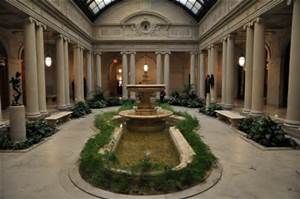Jul 12 2016 - Oct 2 2016
New York City, NY
It would be difficult to think of an artist further removed from the muck and misery of the battlefield than Jean-Antoine Watteau (1684–1721), who is known as a painter of amorous aristocrats and melancholy actors, a dreamer of exquisite parklands and impossibly refined fêtes. And yet, early in his career, Watteau painted a number of scenes of military life, remarkable for their deeply felt humanity and intimacy. (...) But the martial glory on which most military painters of the time trained their gaze — the fearsome arms, snarling horses, and splendid uniforms of generals glittering amid the smoke of cannon fire — held no interest for Watteau, who focused instead on the most prosaic aspects of war: the marches, halts, encampments, and bivouacs that defined the larger part of military life. Inspired by seventeenth-century Dutch and Flemish genre scenes, the resulting works show the quiet moments between the fighting, when soldiers could rest and daydream, smoke pipes and play cards.
Watteau produced about a dozen of these military scenes, but only seven survive. (...) Among the paintings, drawings, and prints are four of the seven known
paintings — with the Frick’s own Portal of Valenciennes as the centerpiece — as well as the recently rediscovered Supply Train, which has never before been exhibited publicly in a museum. Also featured are about twelve studies of soldiers in red chalk, many directly related to the paintings on view.
The exhibition is rounded out by a selection of works by Watteau’s predecessors and followers. These works shed light on the ways in which Watteau transformed the painting of military life in Europe, demonstrating his pivotal influence on the genre.
Credit: Exhibition Overview from The Frick Collection website.
Whether you go or not, the exhibition catalog Watteau's Soldiers: Scenes of Military Life in Eighteenth-Century France offers a new interpretation of Watteau’s military works. It includes a catalogue raisonné of all Watteau works related to military subjects, and a lively and accessible essay by Aaron Wile that explores Watteau’s engagement with the cultural history of war, and the ordinary soldier’s experience of it. This visually appealing new volume is a welcome, thought-provoking study of a little-known aspect of this well-loved artist’s career.
Exhibition Venues & Dates
Jul 12 2016 - Oct 2 2016
New York City, NY

